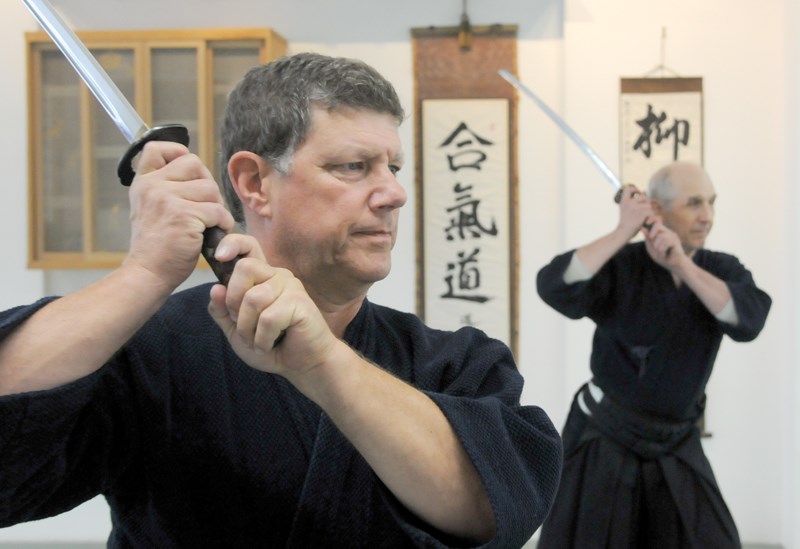“The sword is the soul. Study the soul to know the sword.”
- The Sword of Doom (1966)
Samurai stormed the imperial palace in Kyoto.
It was Jan. 3, 1868.
From the far west and the far south the rebels came to Japan’s imperial capital in a bid to protect their country from foreign nations.
It was a coup d’état. A civil war followed. A new ruler was installed. The capital was moved to Tokyo. The age of feudalism was ending.
The political structure of Japan was transformed while industrialization swept across the country.
“There’s no need for samurai anymore,” reflects Joel Posluns as he discusses an upcoming display of Japanese Swordsmanship.
Posluns’ sword is a practice blade that’s likely not as sharp as a steak knife.
“If we were practising partner-to-partner with a sharp sword, I think we’d run out of partners soon enough,” he says.
But Posluns isn’t preparing to duel out of duty and honour. Instead, he’s practising the art of Ryushin Shouchi Ryu.
“It’s turned into a much more spiritual pursuit,” Posluns says of the craft whose practitioners have dwindled to a “few hundred” in the world.
“We’re one of the smallest schools. I don’t even know how we’ve survived this long.”
Translated by writer and martial artist Frank Nieves, Ryushin means “Mind or Heart of the Willow Tree.” The willow tree bends but Nieves notes that it keeps its leaves, even in winter. Shouchi is loosely translated as “shining wisdom.”
The words are meant to convey strength and flexibility in body and spirit, according to Nieves.
“It’s pretty esoteric,” Posluns says. “It’s not for everybody.”
Posluns has been a martial artist for 40 years but it’s only recently that he’s picked up the sword – thanks to one teacher and his long-distance relationship.
“Tiki Sensei wandered into my dojo,” Posluns recounts.
One of the few instructors in Ryushin Shouchi Ryu, the sensei was on the North Shore to visit his girlfriend in Bowen Island.
Following the instructions of another sensei, Tiki dropped by Posluns’ Lower Lonsdale dojo and demonstrated the style before a rapt class.
“What we liked about this, it was a kind of antithesis to the more traditional styles,” Posluns recalls.
The more traditional styles favour a bigger, heavier sword and motions intended to cleave the opponent “from stem to stern.”
This sword is shorter and faster. An experienced swordsman draws the blade like a gunfighter, sometimes using one-handed swipes and cuts. But while the movements of the sword are small and precise, the movements of the swordsman must be dynamic, running, jumping, and striking before hitting the ground.
The art is similar to aikido, Posluns notes.
“At a certain point your aikido practice changes because you’re not 20 years old anymore,” he says. “This was a natural progression for me to move into something that I could practise by myself and I could keep doing into my 80s and 90s.”
Rather than retiring from martial arts with a beaten up body, Posluns says studying the sword allows him to take a more cerebral, philosophical approach.
“This is all about seeing the scenario in your mind,” he explains. “You don’t really have an opponent.”
Posluns visualizes his combatants, allowing his mind to lead his hand, and striking with internal energy.
“The explosive force doesn’t come from a physical intensity like the MMA guys,” he explains. “It comes from how the body works and how you generate power through breathing and extension and compression.”
Practising the art can changes the way you think, helping you realize what’s essential.
“You start not worrying about the small stuff because you realize that’s not life and death.”
Posluns used to work in financial services.
“I changed my life at 40 to decide to do aikido full time,” he says.
Martial arts transformed his outlook on life and relationships. Studying the sword is another step in his education even if it may be a dying art.
“It’s very hard. Even in Japan, the young people, they’re not really interested in it and a lot of the older people that are carrying on are dying out,” he says.
But there are students in Europe and North America who remain interested.
Sunday’s demonstration should take about one hour and feature Ryushin Shouchi Ryu practitioners from all over the world, Posluns says.
“I think we’re the ones that are going to keep it alive.”



